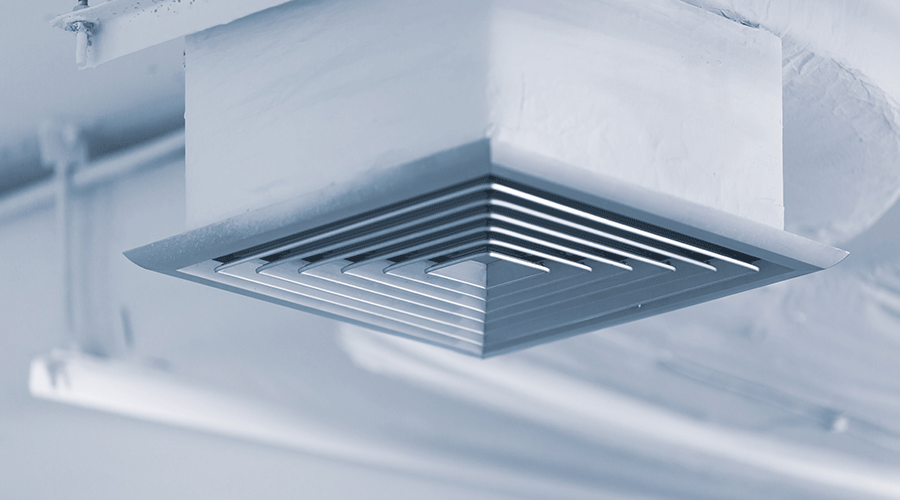Every year, hospitals admit hundreds of thousands of people with flu, respiratory syncytial virus or COVID-19, often stretching institutional capacity. While those illnesses are often thought of as seasonal, other serious respiratory infections such as measles and meningitis have been on the rise, underscoring that preventing the spread of airborne disease is a year-round concern.
Pathogens can spread rapidly in hospitals, putting patients, visitors and staff at risk. Clean, well-ventilated air is critical, but older hospitals can struggle with outdated HVAC systems, and even new facilities face trade-offs related to cost and other considerations. For these reasons, forward-looking healthcare facilities managers are shifting their mindsets when it comes to ventilation from the so-called set it and forget it approach to ongoing recalibration and resilience.
It can be helpful to look at the way that approach plays out in practice, as well as the questions managers should ask to stay ahead of a rapidly changing landscape.
Understanding the standards
Ventilation systems bring fresh outdoor air inside, filter or disinfect the air and improve air flow. Effective systems involve several related factors:
Air flow volume. The U.S. Centers for Disease Control and Prevention (CDC) recommends hospital ventilation systems deliver at least five air changes per hour (ACH). Some international experts recommend a new minimum ventilation standard of about 30 cubic feet per minute per person (cfm/p). Some healthcare systems also mandate 100 percent outside air to reduce the airborne spread of viruses and bacteria.
Level and type of filtration. Hospital filtration systems are vital for maintaining air quality and preventing pathogen transmission. Managers need to consider a filter’s minimum efficiency reporting value (MERV), which reflects a filter's ability to capture particles.
The CDC recommends filters with ratings of MERV 13 or higher, which trap most fungi, bacteria and viruses. Pre-filters, typically with MERV 8-9 ratings, capture larger particles at the outset, offering cost-effective initial filtration with minimal pressure drop. Final filters with a minimum MERV 14 rating further purify the air, trapping smaller contaminants.
For critical areas such as surgical suites and isolation rooms, HEPA filters are indispensable. With a minimum efficiency of 99.97 percent at 0.3 micrometer (μm), HEPA filters excel at capturing tiny particles, providing optimal air purification. Specifying HEPA filters in such areas is a best practice.
Other air treatments. Beyond the use of physical air filters, managers can consider treatments such as ionization and ultraviolet disinfection, potentially together with photocatalytic oxidation. Research also is demonstrating the potential benefits of incorporating biological indoor air purification methods, such as plants and algae.
Knowing the standards does not result in a one-size-fits-most plan. Managers need to consider different combinations of approaches in different facilities and even different parts of the same hospital, and those needs can change rapidly.
Changing and variable needs
Hospitals are evolving with new technologies and standards of care. While some services have become more outpatient focused, many facilities are renovating to enhance their inpatient services and increase revenue. To that end, nearly two million square feet of new U.S. healthcare facility construction is constantly under way. Managers also oversee hospitals that are 100 years old or older, where they focus on maintaining operations and ensuring they meet current building codes and regulations.
Those ventilation requirements vary depending on the area within the facility:
- Airborne infection isolation rooms or negative-pressure isolation rooms are used for patients with airborne infections. These rooms require at least 12 ACH to prevent the spread of contaminants, although older facilities might have lower ACH levels.
- Conventional operating rooms should have 25 ACH. Over time, this rate might fall to approximately 20 ACH, but regular maintenance can help maintain the higher standard.
- Specialized outpatient facilities, such as outpatient surgical, endoscopy, infusion, renal dialysis and some imaging facilities, have specific ventilation requirements detailed in ASHRAE standards. These and other high-risk areas that include emergency rooms, burn units and recovery wards might have additional requirements, including temperature control, humidity levels and higher ACH to handle the increased risk of infection and need for sterility.
Even before the COVID-19 pandemic, facilities could isolate different areas for precise ventilation management. That flexibility is important because hospitals are a dynamic environment. Ventilation systems can be dynamic, too. New equipment collects and provides data on everything from carbon dioxide levels — monitoring the CDC recommends — to levels of small particulate matter for real-time control.
Managing effective ventilation systems goes beyond thinking about the space itself to considering hour-by-hour changes, such as the number of people in the building, seasonal factors such as potentially increased viral load, and emerging risks, such as the burden of wildfire smoke, which is increasingly common in many areas. These factors mean healthcare professionals and facilities managers must address sometimes challenging trade-offs and a growing range of questions.
Asking strategic questions
When it comes to ventilation services in healthcare facilities, it helps to focus on education, resilience and life-cycle-cost considerations. Although ventilation might be part of the mechanical-electrical-plumbing design, success requires educating a range of stakeholders. Managers should engage decision-makers in exploring the trade-offs and accounting for factors that contribute to system effectiveness.
Ventilation resilience in hospitals refers to the capacity of a facility's ventilation systems to withstand and adapt to challenges and disruptions while maintaining a safe and healthy environment for patients, staff and visitors.
For example, since the start of the COVID-19 pandemic, WSP has worked on the design of the regional infectious containment unit at Meritus Medical Center in Hagerstown, Maryland, to make it more ventilation resilient than the rest of the hospital, which was built years before. The cutting-edge facility boasts dual, fully redundant exhaust fans with high-velocity discharge positioned 10 feet above the roofline. Each fan is outfitted with a bag-in, bag-out HEPA filter housing and bubble-tight isolation dampers on the roof.
Every patient room also is equipped with a room pressure monitor, while the suite’s anterooms feature their own pressure-monitoring systems. Operating in two distinct modes, the unit functions normally as a medical-surgical patient suite but seamlessly transitions to an infectious isolation mode where all 20 patient rooms adopt negative pressure, ensuring a minimum of 12 ACH. This transformation extends to the entire suite, establishing negative pressure in relation to the main hospital, enhancing containment capabilities and bolstering infection-control measures. This approach provides performance and flexibility.
Another critical topic is managing construction and maintenance costs. Many healthcare systems are understandably looking for cost-effective approaches to facility management without sacrificing safety. For managers to make more fully informed decisions, it helps to secure data on the initial and total life-cycle costs associated with a proposed ventilation solution. It is a complex analysis.
Healthcare facilities managers are thinking beyond minimum acceptable targets and methodologies. They are asking questions that include how they can prepare for potential service changes, how they can align with organizational strategy and how they can prepare their facilities for the next pandemic.
The benefits of this approach go far beyond compliance with standards or even reducing the spread of disease. Effective ventilation rates can reduce healthcare costs and absenteeism and improve cognitive function, work performance and even healthcare cost savings, according to The Lancet. Those benefits can help everyone breathe easier.
April Woods is senior vice president and Florida building systems director with WSP, an engineering, environment and professional services firm. Gary Hamilton is the national healthcare practice leader for property and buildings with WSP.

 Contaminants Under Foot: A Closer Look at Patient Room Floors
Contaminants Under Foot: A Closer Look at Patient Room Floors Power Outages Largely Driven by Extreme Weather Events
Power Outages Largely Driven by Extreme Weather Events Nemours Children's Health Opens New Moseley Foundation Institute Hospital
Nemours Children's Health Opens New Moseley Foundation Institute Hospital Code Compliance Isn't Enough for Healthcare Resilience
Code Compliance Isn't Enough for Healthcare Resilience Ribbon Cutting Marks First Phase Completion for New Montefiore Einstein Facility
Ribbon Cutting Marks First Phase Completion for New Montefiore Einstein Facility